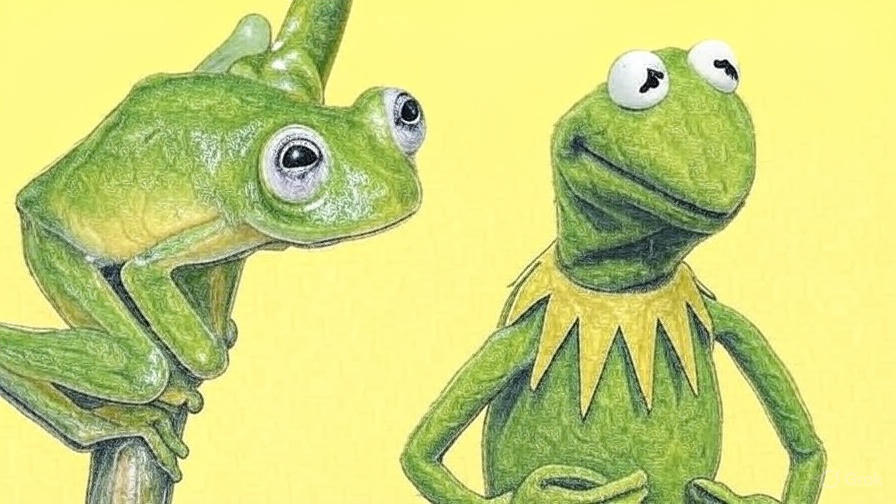Real-Life Kermit Frog Found in Costa Rica’s Rainforests [7 Facts]
Introduction
On September 23, 2025, the popular nature account @AMAZlNGNATURE shared a viral tweet about a stunning scientific discovery: a real-life frog that looks exactly like the beloved Muppet character Kermit the Frog. The post, featuring side-by-side images of the frog and Kermit, quickly grabbed global attention.
This frog, scientifically named Hyalinobatrachium dianae, was first discovered in Costa Rica in 2015. Known as a glass frog, it has a translucent green body and bulging white-rimmed eyes—features that bear an uncanny resemblance to Jim Henson’s famous puppet.
Let’s dive into 7 fascinating facts about this discovery and why it matters.
Scientists Have Discovered Real-Life Kermit The Frog Living In Costa Rica pic.twitter.com/ySUfErnjNM
— Nature is Amazing ☘️ (@AMAZlNGNATURE) September 23, 2025
1. The Frog Species Behind the Discovery
The frog is a member of the Centrolenidae family, commonly known as glass frogs. Its transparent skin allows observers to see parts of its internal organs—a natural camouflage in rainforest environments.
2. Location: Costa Rica’s Rich Biodiversity
This frog lives in the Caribbean foothills of Costa Rica, an area well known for its rainforests, waterfalls, and rare wildlife. Costa Rica’s conservation policies have helped protect this species from immediate threats.
3. Viral Tweet Sparks Global Interest
The tweet posted at 15:46 UTC (9:16 PM IST) on September 23, 2025, paired the frog’s photo with Kermit’s image and the caption:
“Scientists Have Discovered Real-Life Kermit The Frog Living In Costa Rica.”
This playful comparison helped the discovery reach millions online.
4. Why It Looks Like Kermit
The frog’s round white eyes with dark pupils are the key reason for its resemblance. Kermit, created in 1955 by Jim Henson, shares the same eye design, along with the iconic green skin tone.
5. Scientific Importance
Beyond its meme-worthy looks, the discovery adds to research on amphibian diversity in Central America. Scientists believe such species are crucial indicators of environmental health.
6. Pop Culture Meets Science
The comparison to Kermit is more than just fun—it highlights how popular culture can boost interest in wildlife conservation. This connection brought attention to frogs at a time when amphibian populations are declining globally due to climate change and habitat loss.
7. Public Engagement and Memes
After the post went live, social media users responded with memes, jokes, and other frog comparisons, showing how humor can drive awareness for scientific findings.
Conclusion
The discovery of Hyalinobatrachium dianae—the so-called real-life Kermit the Frog—is a fascinating mix of biology and pop culture. On one hand, it reminds us of Costa Rica’s extraordinary biodiversity. On the other, it shows how science can capture global attention when paired with a cultural icon.
FAQs
Q1: Is this frog officially called “Kermit the Frog”?
No. Its scientific name is Hyalinobatrachium dianae. The nickname “real-life Kermit” is a playful reference.
Q2: When was the frog discovered?
Scientists documented it in 2015, but the recent viral tweet revived interest.
Q3: Why is it called a glass frog?
Because of its transparent skin, which reveals parts of its internal organs.
Q4: Where can this frog be found?
It inhabits Costa Rica’s Caribbean foothills in rainforest ecosystems.
Q5: Why is this discovery significant?
It raises awareness about biodiversity and conservation while making science more accessible through pop culture.
Opinion
This discovery sits at the intersection of science, culture, and digital media. While it is tempting to treat the glass frog as a novelty, it also raises deeper questions: How often do we notice nature only when it mirrors human culture? Does the global fascination with a frog that resembles a puppet reveal more about us than the animal itself?
From one angle, it is a triumph for conservation awareness—a reminder that protecting ecosystems can bring delightful surprises. From another, it shows how easily science is filtered through entertainment lenses. If this frog didn’t look like Kermit, would millions care?
Ultimately, the “real-life Kermit” teaches us that nature is full of stories waiting to be told, but it depends on us—humans—to listen, share, and protect them.


0 comments